1lumen selects and reviews products personally. We may earn affiliate commissions through our links, which help support our testing.
Nightwatch NS14R review
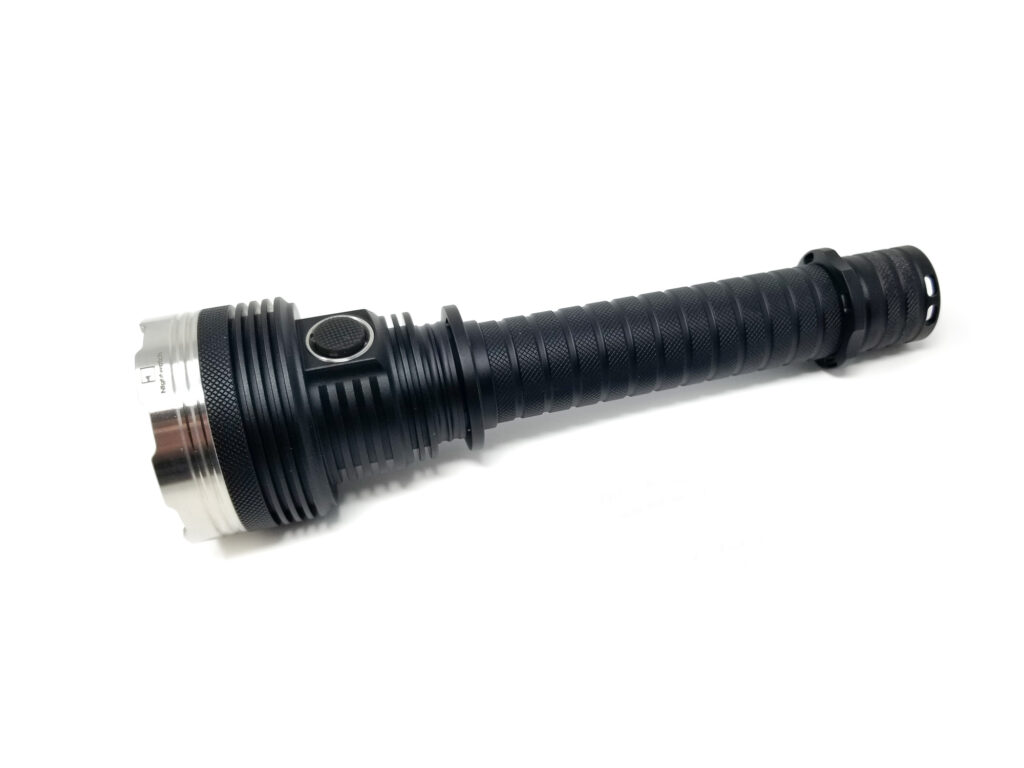
Nightwatch NS14R specs
| Brand & Model | Nightwatch NS14R |
|---|---|
| Flashlight category | High Lumen Flashlights |
| LED | 14*SSQ55.2 |
| Max. output | 50,000 lumens |
| Max. beam distance | 632 meters |
| Max. beam intensity | 100,000 cd |
| Battery config. | 2*21700 |
| Onboard charging | None |
| Main modes | 4 |
| Blinkies | Strobe |
| Waterproof | Not listed |
| Review publication date | October 2023 |
Review intro:
It’s feeling like deja vu here in my workspace because I’ve been asked to review another Nightwatch NS14 light (courtesy of Nealsgadgets). Readers following 1Lumen know we have reviewed the first NS. the mental (chaotic?) NS59v1, skipped the 2nd gen NS59v2, and went right to the 3rd gen of the NS: The NS14. That one, while an appreciable upgrade from the gen 1 NS, sporting 14 high intensity LEDS, wasn’t enough of an upgrade to be an upgrade (I actually liked the NS59v1 better…just).
Well, on deck today is the latest NS14, the NS14R. I’m not sure what the ‘R’ denotes, but there are actually two versions of the R. There’s the one I’m reviewing with new domed LEDs, and one with domeless, round die LEDs (the ambiguous Yinding-style ones floating around). I’m glad to see some new LEDs on board, but I’m more chuffed that his one comes in a new host, with a new switching setup, and new tailcap. It’s also promising a performance boost. Everything else is the same, so let’s see what puts the ‘R’ in the rrrrrrrrrr.
Package quality.
Nightwatch lights come in plain boxes. In my experience they’re either intact or look like they came out on the wrong side of a footballers brawl. This time the box was haphazardly taped up, but intact. Inside the light was bubble wrapped. Here’s what I got:
- Nightwatch NS14R
- Two Nightwatch branded 21700XP 60 amp 2500 mAh button top 21700s
The product page says the battery wrappers are incorrect on the capacity, and that these are 3800 mAh cells. Still 60 amps for 3800 mAh seems a bit dubious since the highest ampacity cells are generally 3000 mAh or less. The light doesn’t come with batteries by default, but it’s strongly recommend to get them with the bundle since this thing needs the 60 amp cells for maximum output (trust me, it does…just get them).
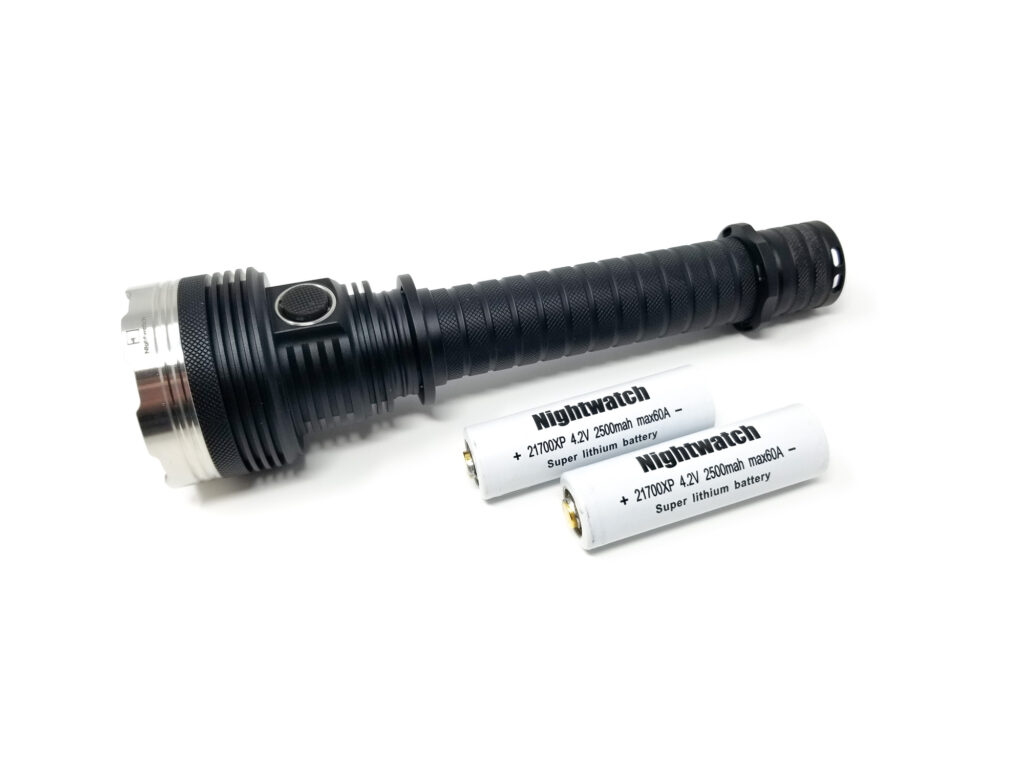
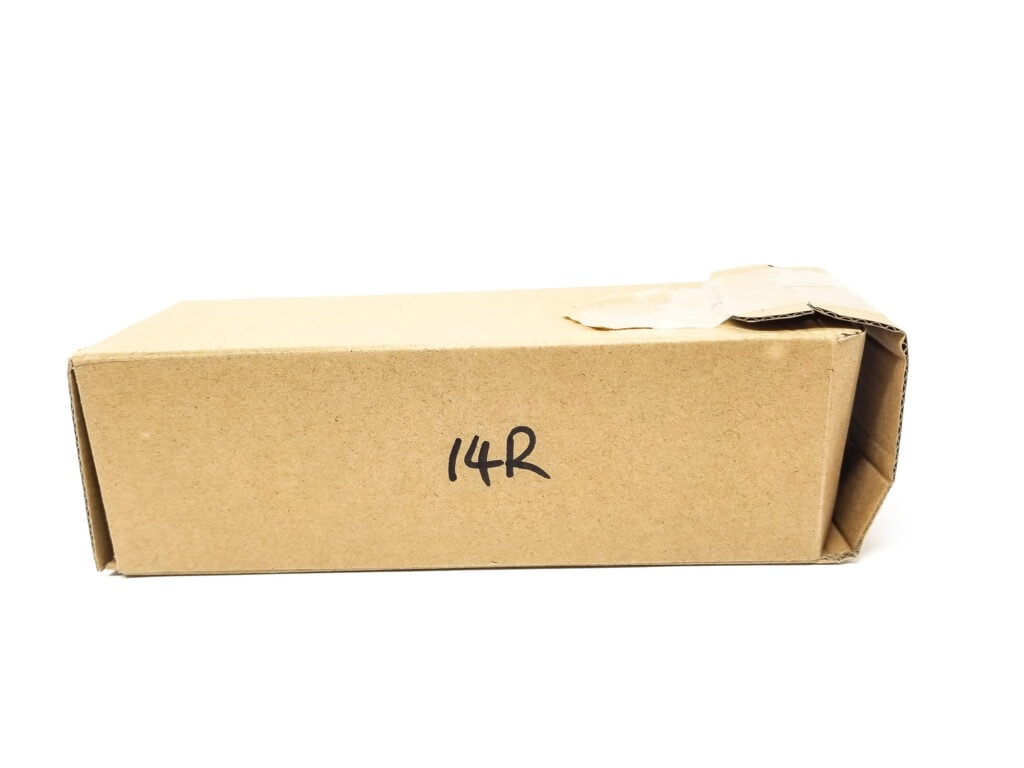
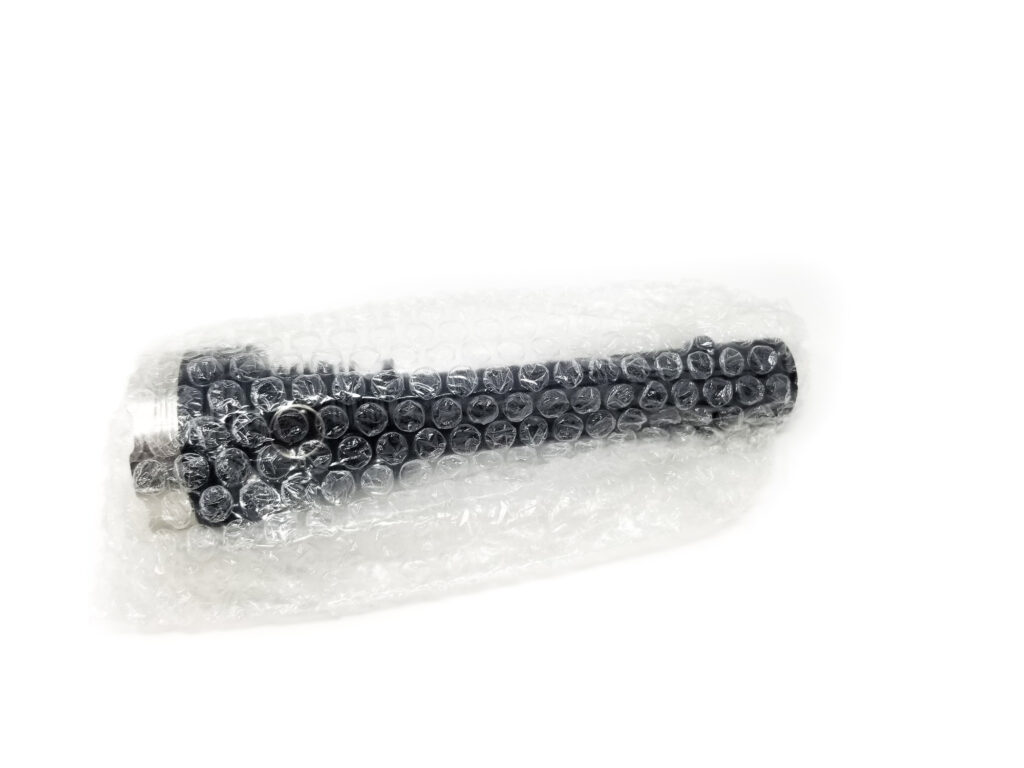
Flashlight in use, Build Quality, and Warranty
The NS14 was a versatile illumination tool, and so’s the NS14R. It can make a little light, or a lot of light, so it can do just about anything a general purpose flashlight is called upon to do. The 2×21700 format means it’s not as maneuverable as a smaller single cell light, and pocket carry is out. I wish Nightwatch sold a holster for this one since that’s going to be the best carry option. If you have a holster for something like a Convoy L21B, or an Acebeam L19, the NS-series lights would work with those. The weight is concentrated at the head, but the balance point is pretty good.
The head has been totally revised and now features a side e-switch. I’m really glad Nightwatch made this change since the tail switch wasn’t very refined on the previous NS models. The switch sits in a shiny bezel slightly forward of the battery tube in a flat spot so it’s not hard to find by feel. The boot is proud and firm, and the switch effort is on point. It has a nice feel and positive clicks also. It’s not backlit though. The rear tactical ring and front lanyard mount ring are still present also. These are removable and feature lanyard holes for attaching a shoulder strap or lanyard. The rear ring can rotate. Tail standing is possible, but it’s so top heavy that I don’t recommend it. The rear ring acts as an anti-roll feature so it will roll off the table.
Nightwatch lights are generally okay quality, somewhere between Sofirn and Astrolux, and for the price I’m not complaining since for price vs. performance, this is a fantastic value. Value-wise, depending on the LEDs and whether you add batteries, the NS14R sells for around $135 and $155, and I do recommend getting the battery bundle if you don’t have a matched pair of high drain button top 21700s. The light is made from aluminum, and the machining is perfectly adequate and free of major blemishes. There’s a good amount of heat sinking fins on the head and they were precisely machined. The parts fit together nice and flush, and I didn’t notice any quality control issues. The finish is advertised as type III HA hard anodizing, and it’s a semi-gloss black and the same as the NS14. It’s nicely applied and even with no thin or bare areas that I could see.
The light breaks down easily. The bezel unscrewed by hand along with the head and battery tube. The tailspring PCB and driver are held in by brass retaining rings that can be removed with snap ring pliers. There’s no spring for the driver, just a thick brass slug, and the tailcap has a seemingly too-thin coil spring that’s bypassed by a 4.5 mm wide strip of metal contacting the negative side of the battery. This is necessary to handle the massive current load that would otherwise melt that puny spring.
The battery tube threads front and rear are rectangular cut and very sturdy as well as being smooth. The rear threads are fully anodized for mechanical lockout, and the front threads are bare. The tube can be reversed, but the light doesn’t work. The whole thing is sealed up very nicely with dual o-rings at the front and rear of the battery tube, a single o-ring sealing the bezel and a large silicone one sealing the lens. No IP rating is specified, but with no charge port to seal and all those o-rings, I’d imagine heavy rain or a temporary dunking wouldn’t be an issue.
Warranty? I didn’t see any implied, but Neal is good about defective products or issues and will happily send replacement parts if needed.
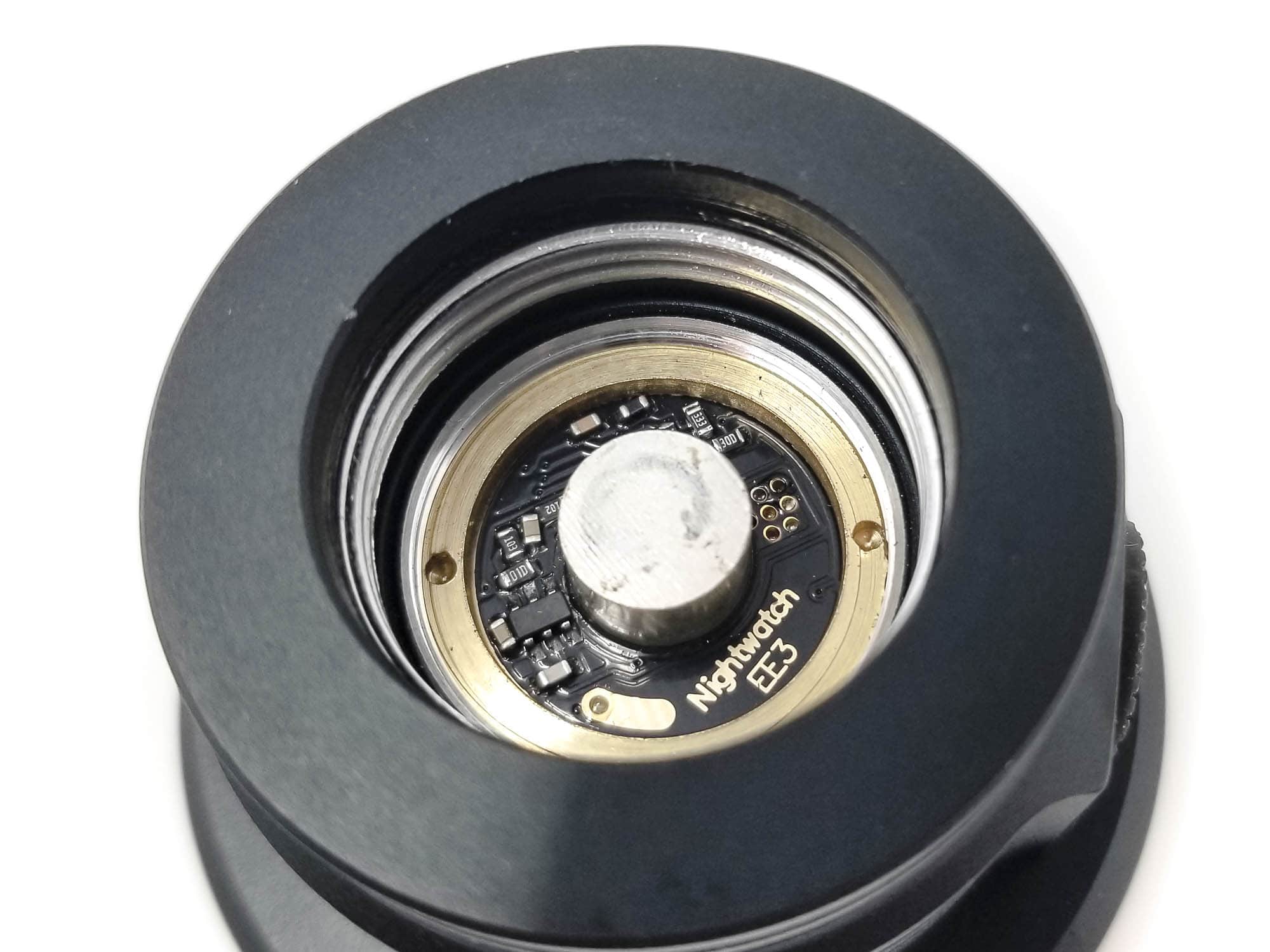
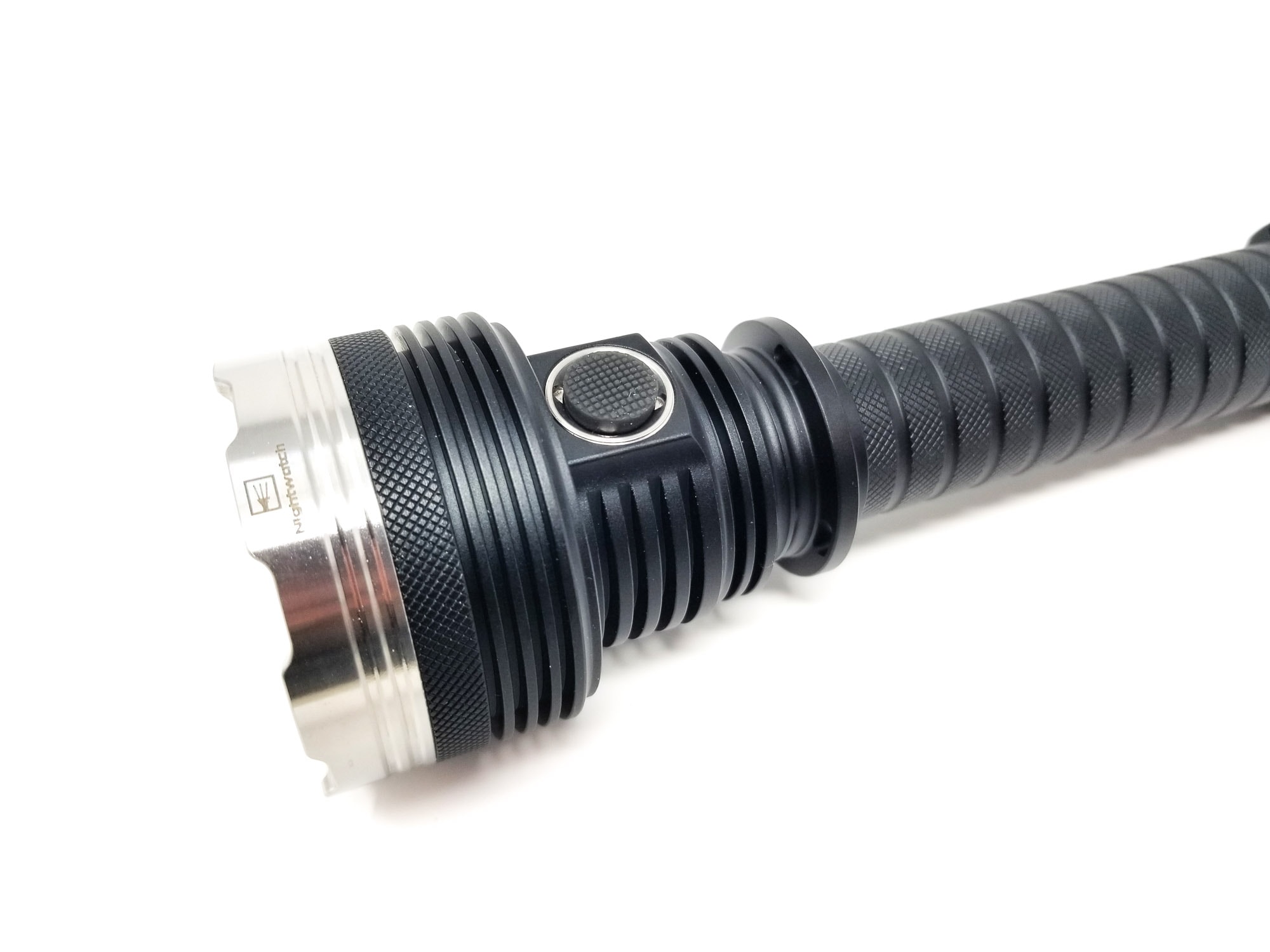
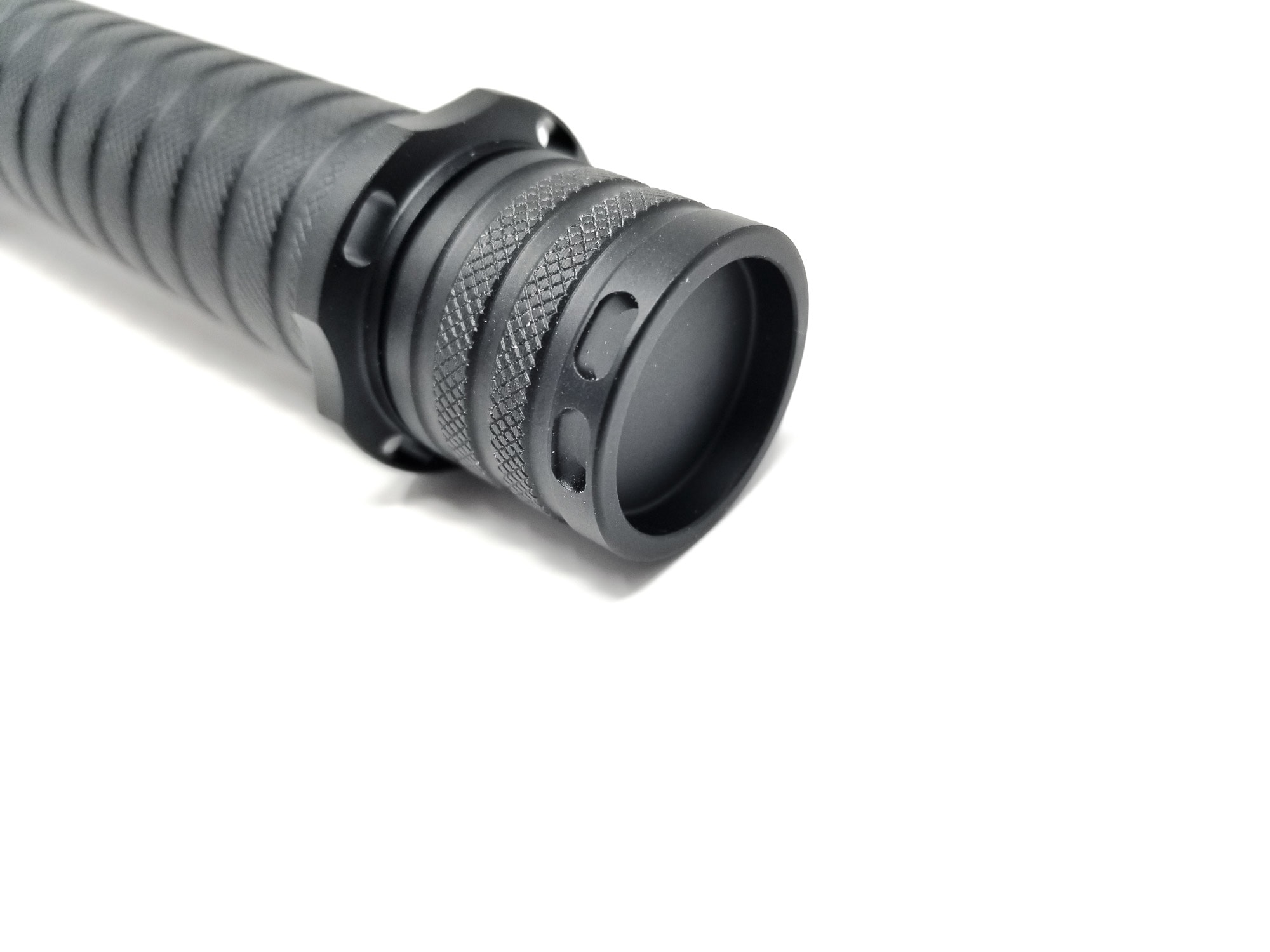
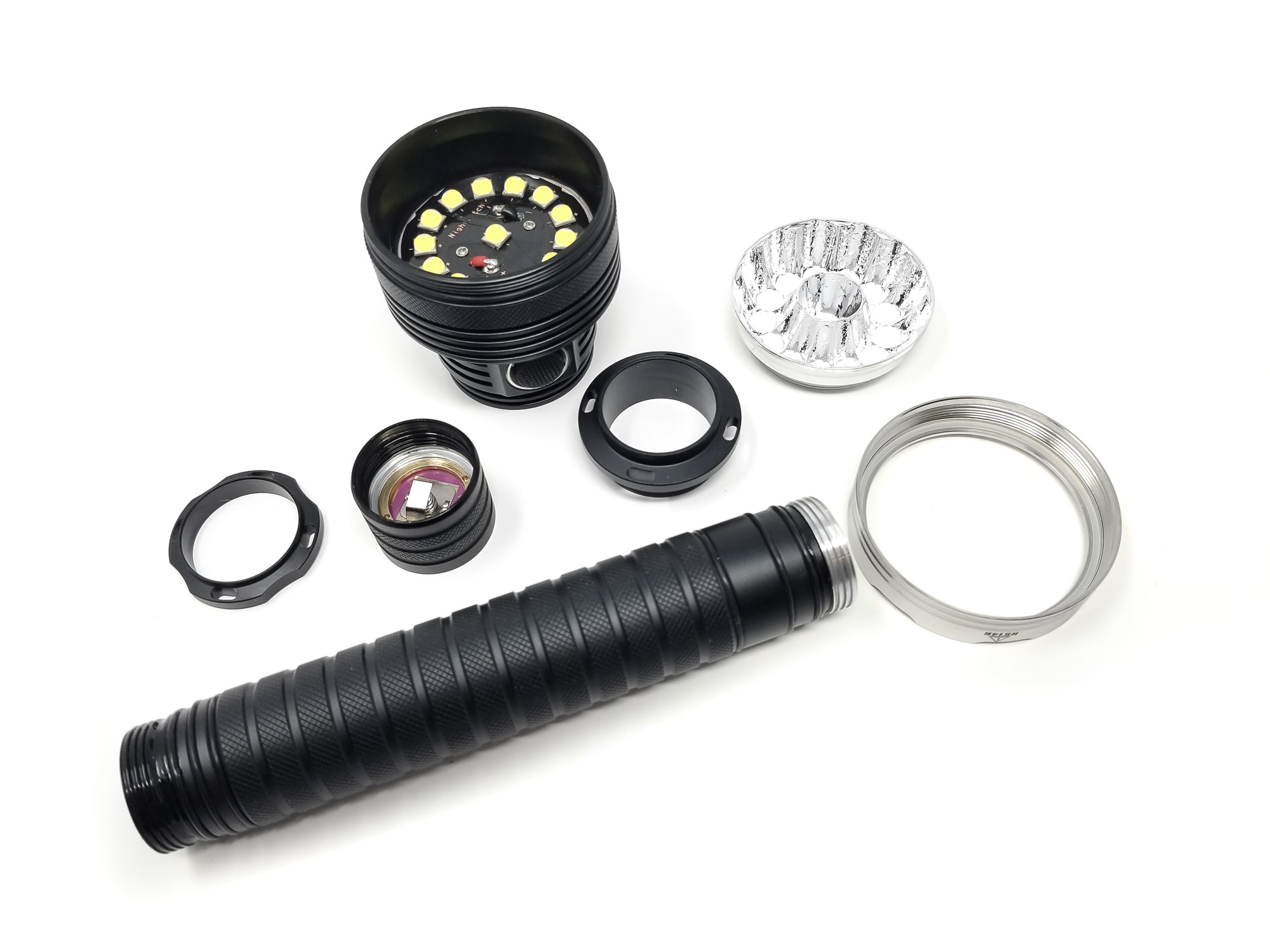
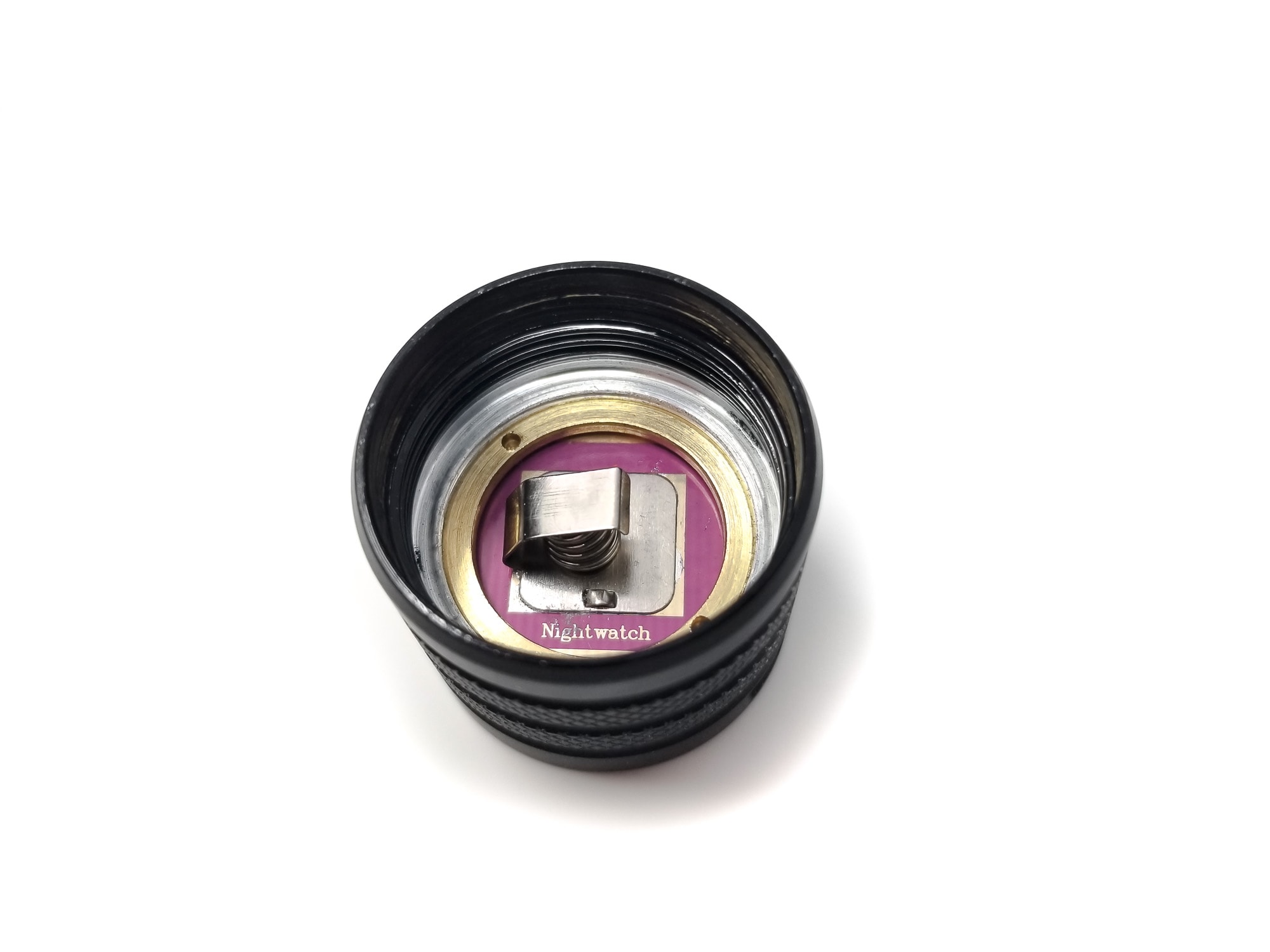
LED, Lens, Bezel, Beam, and Reflector
The NS series have always been fitted with domeless, high intensity LEDs, but the NS14R breaks that tradition and comes with two LED choices: The SFS72 and the SSQ55.2. The SFS72 follows the round-die ‘Yinding’ or ‘egg yolk’ domeless LED whereas the SSQ55.2 is more or less a Chinese clone of the Cree XHP50.3 HD. This is a domed quad-die LED running on 6 volts and promises higher output than the domeless round die option (50,000 Lumens vs. 20,000) and outgoing SFQ55.4 LEDs of the NR14.
Like the other SFxx LEDs, no manufacturer is implied nor mentioned, but these are probably products of Sanan Optoelectronics, a major semiconductor and electronics OEM in China. You get 14 of them arranged in an orange peel reflector. The reflector is identical to the NS14, with a central LED and 13 around the perimeter. The lens is a hardened glass with a (very) light AR coating. It’s held on by a pretty stout stainless bezel that extends about 7 mm over the lens for drop protection. It has chonky crenulations that further protect the lens. The beam you get from this thing is incredible. A huge wall of light, tons of useable spill with impressive beam distance for a sub 60 mm head. It’s impressive!
Spectral measurements:
I used the Opple Lightmaster Pro to measure the flashlight at 1 meter from the sensor.
| Mode: | CCT: | CRI Ra: | duv |
|---|---|---|---|
| Turbo | 5956K | 67.1 | 0.0048 |

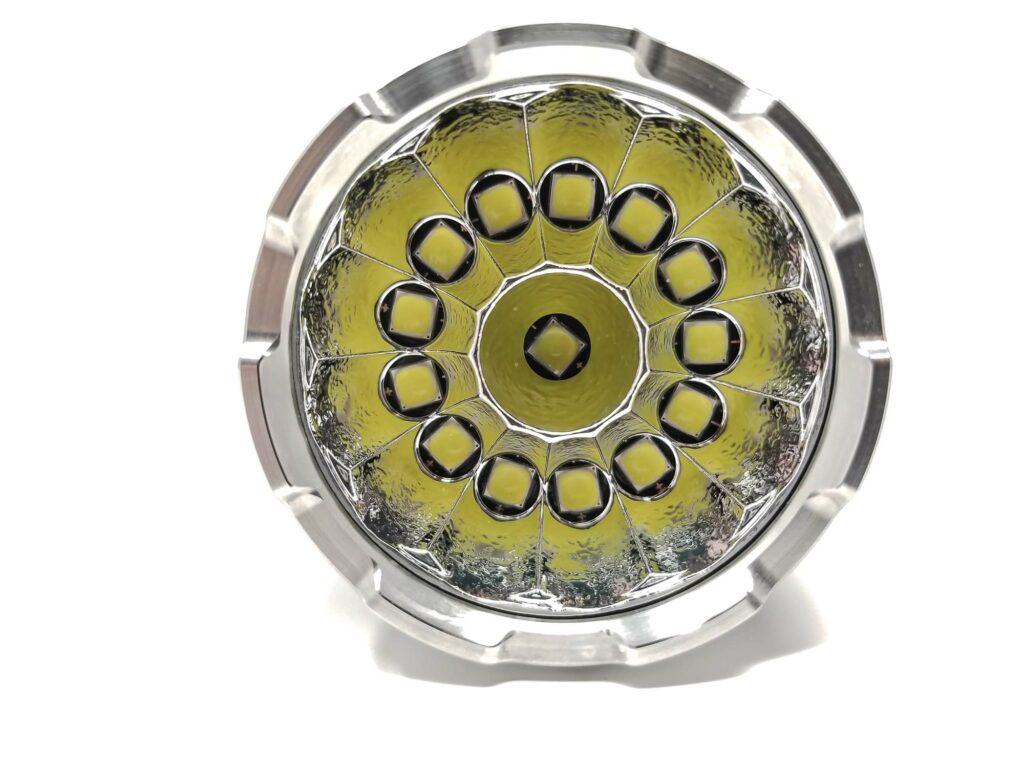
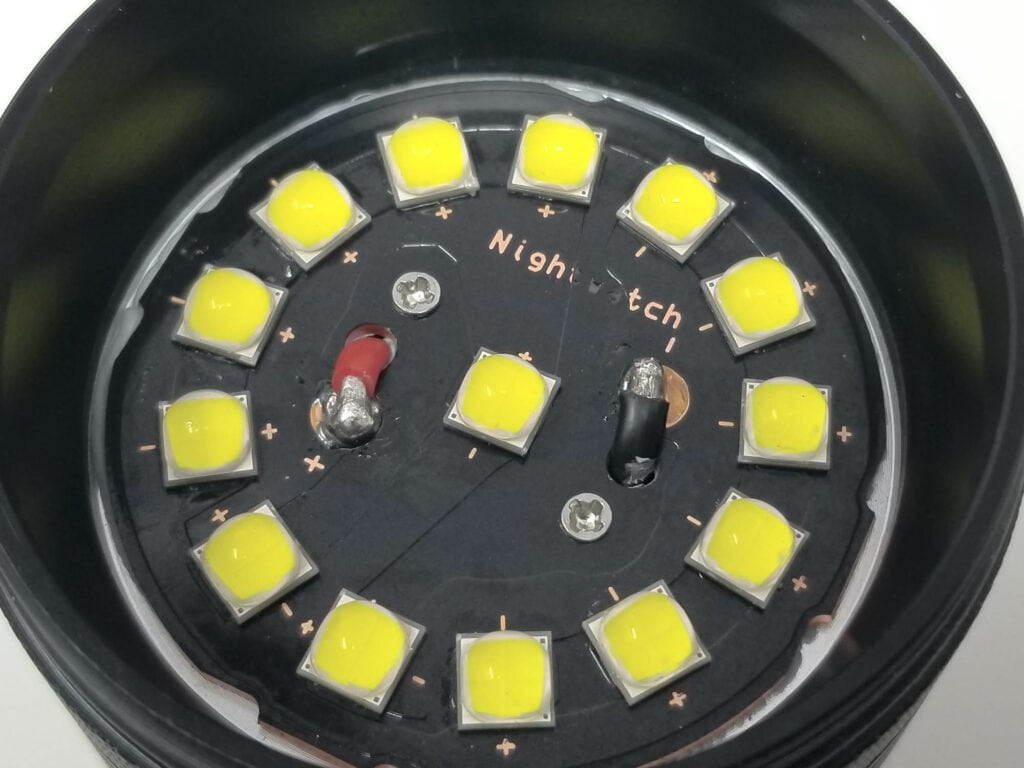
Dimensions and its competition
Dimensions:
| Nightwatch NS14R | Millimeters | Inches |
|---|---|---|
| Length | 215 mm | 8.4 in |
| Head diameter | 58 mm | 2.3 in |
| Body diameter | 27 mm | 1 in |
Dimensions are rounded to the nearest millimeter, and to the nearest tenth of an Inch.
Weight:
| Nightwatch NS14R | Weight in grams | Weight in oz |
|---|---|---|
| Without battery: | 358 g | 12.6 oz |
| With battery | 486 g | 17.1 oz |
Weight is rounded to the nearest gram, and to the nearest tenth of an Oz.
Flashlight size comparison with its competition:
Group 1 left to right: Nightwatch NS59v1, Nightwatch NS14, Nightwatch NS14R
Group 2 left to right: Lumintop PK21, Nightwatch NS14R, Thorfire C8, Speras T10R, Wurkkos DL70, Nitecore MH40S
Group 3 reflectors left to right: Nightwatch NS14, Nightwatch NS14R, Nightwatch NS59v1
Group 4: Nightwatch NS59v1, NS14, NS14R
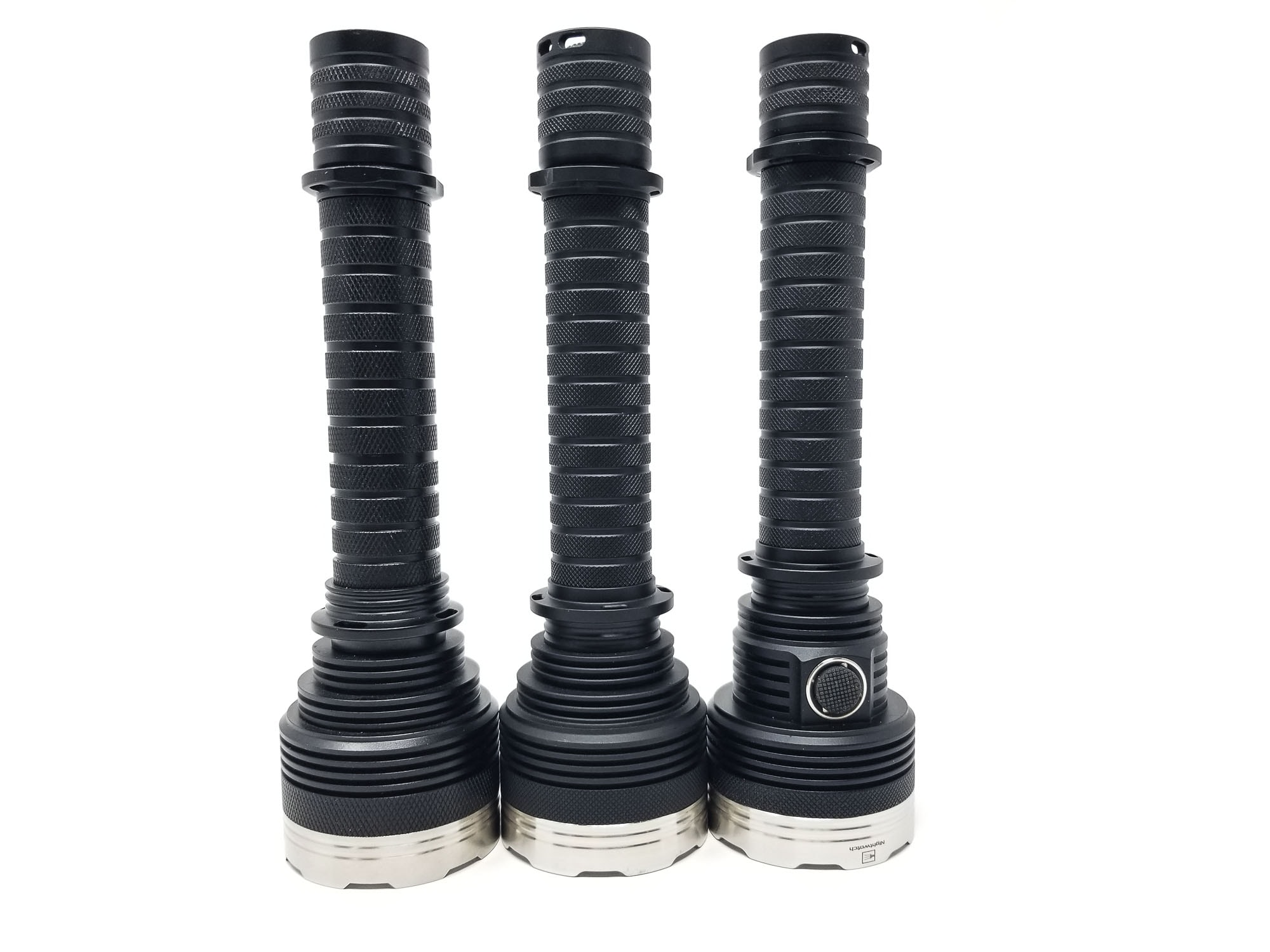
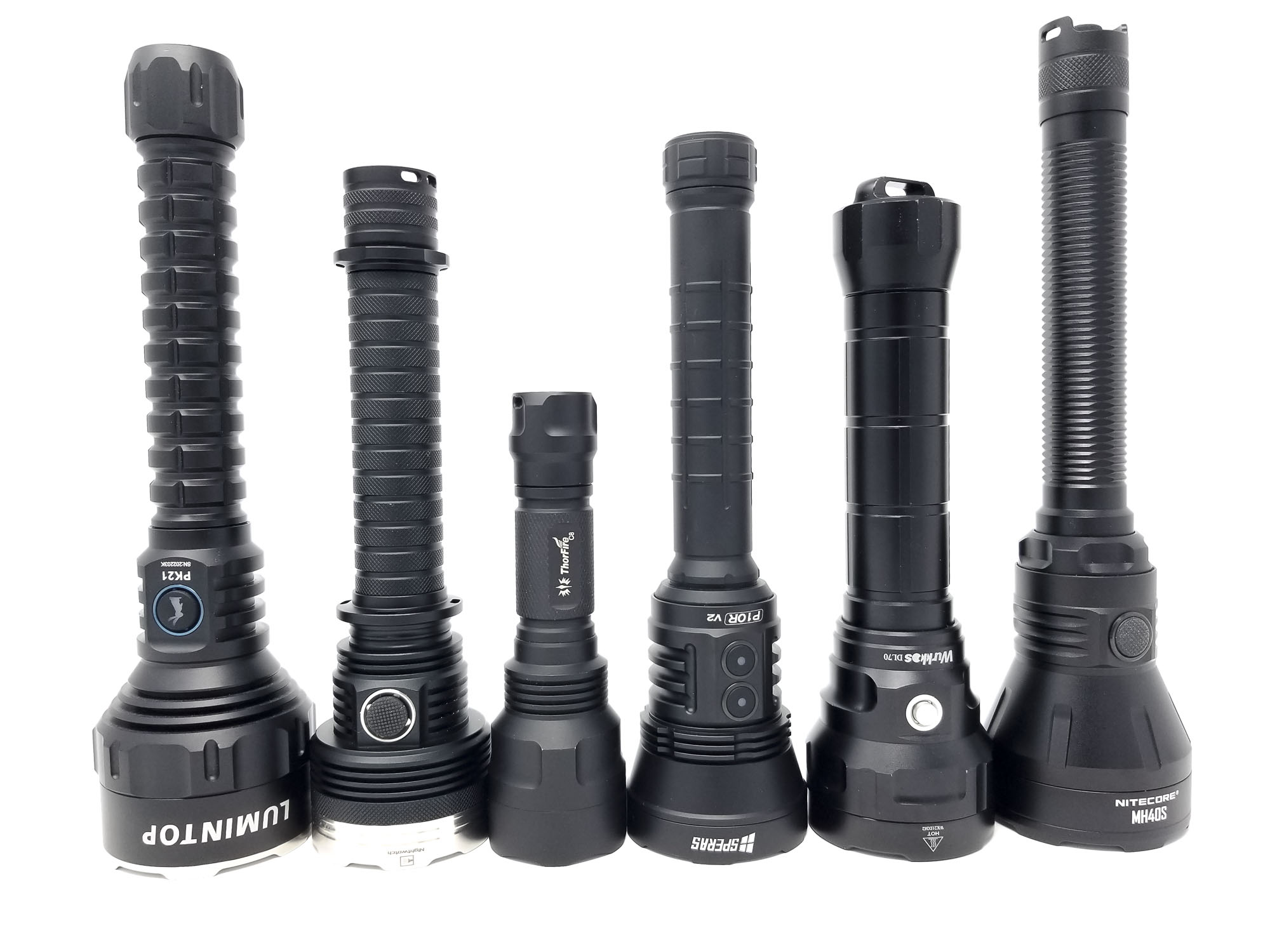
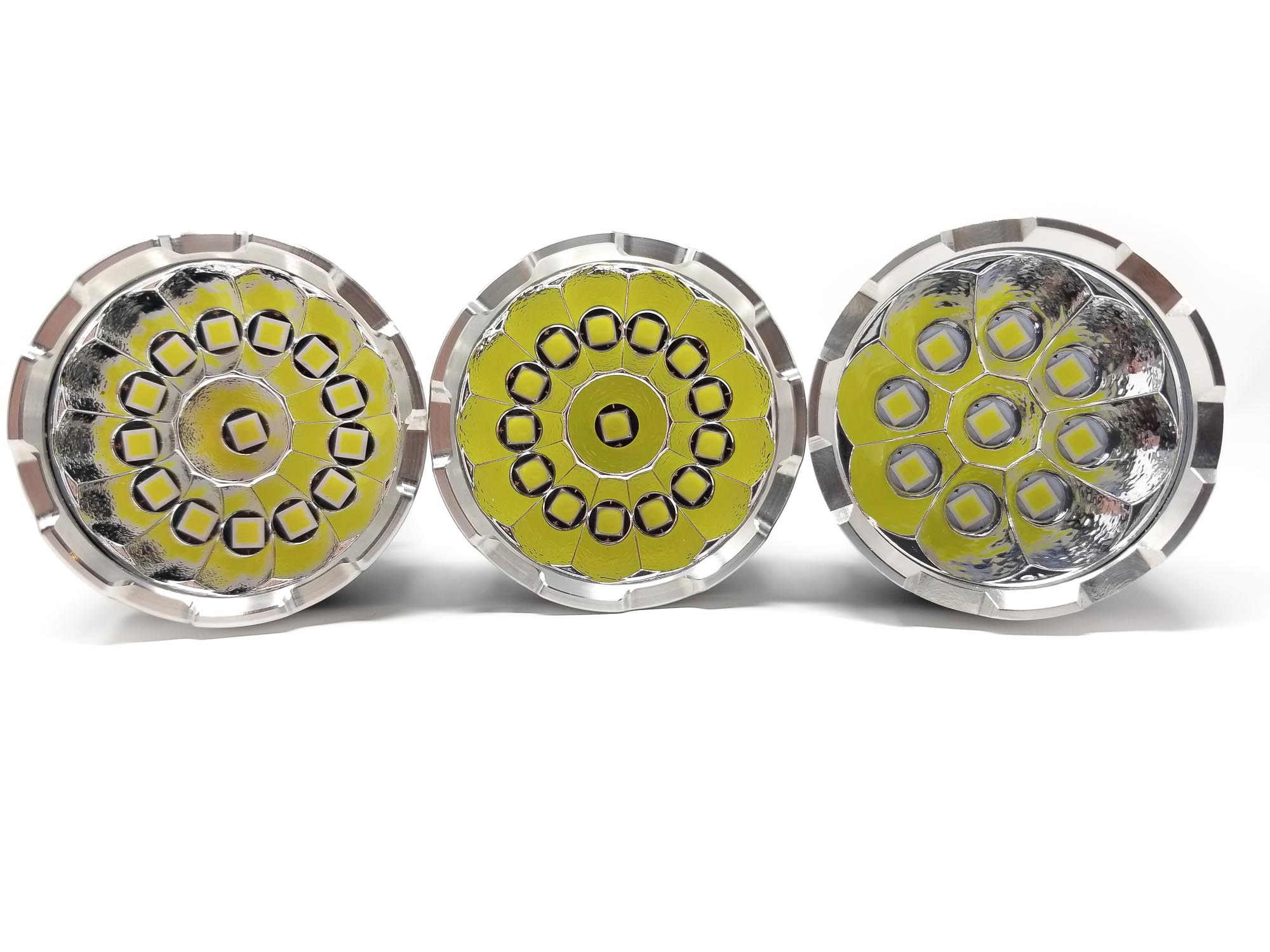
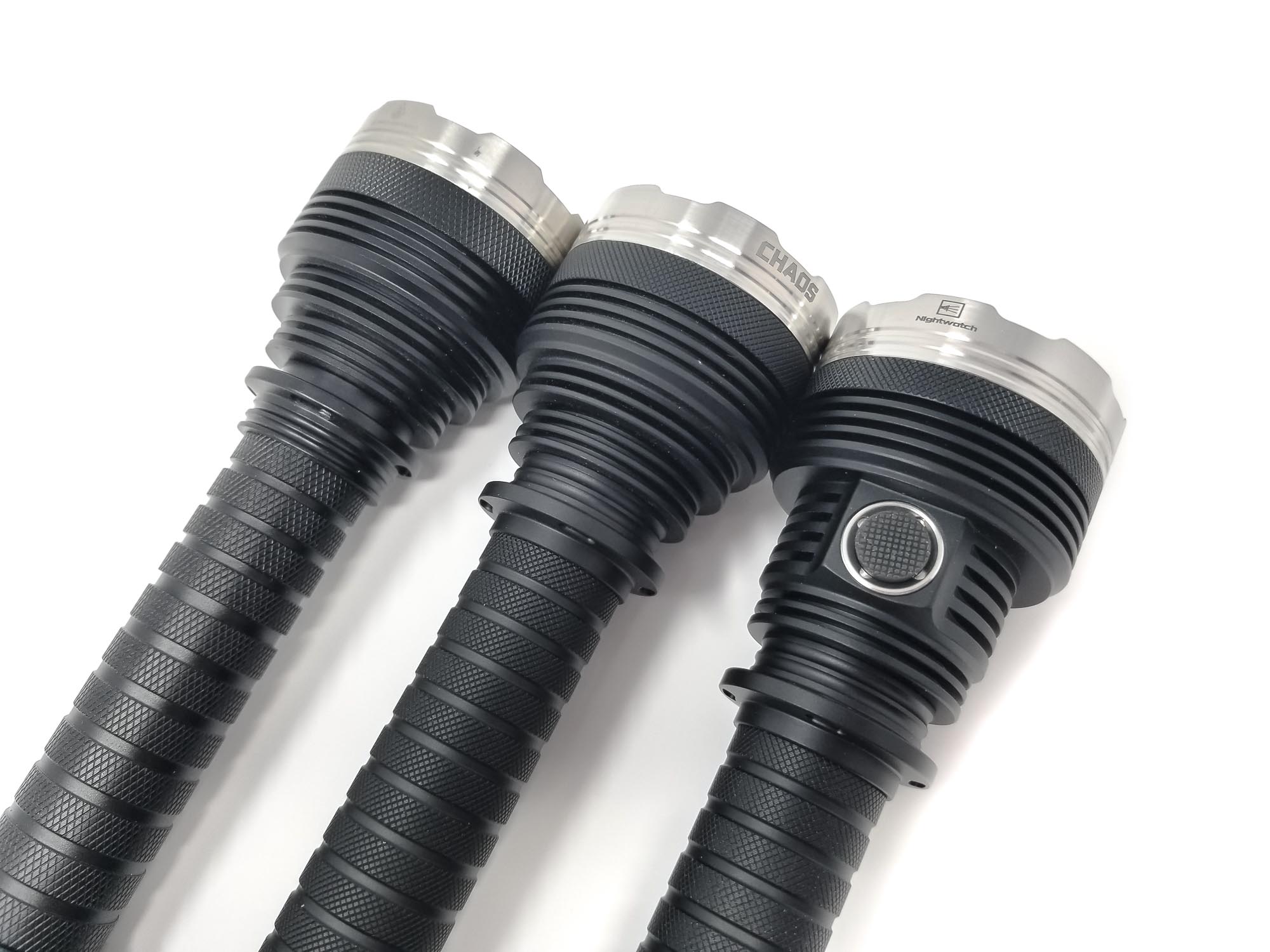
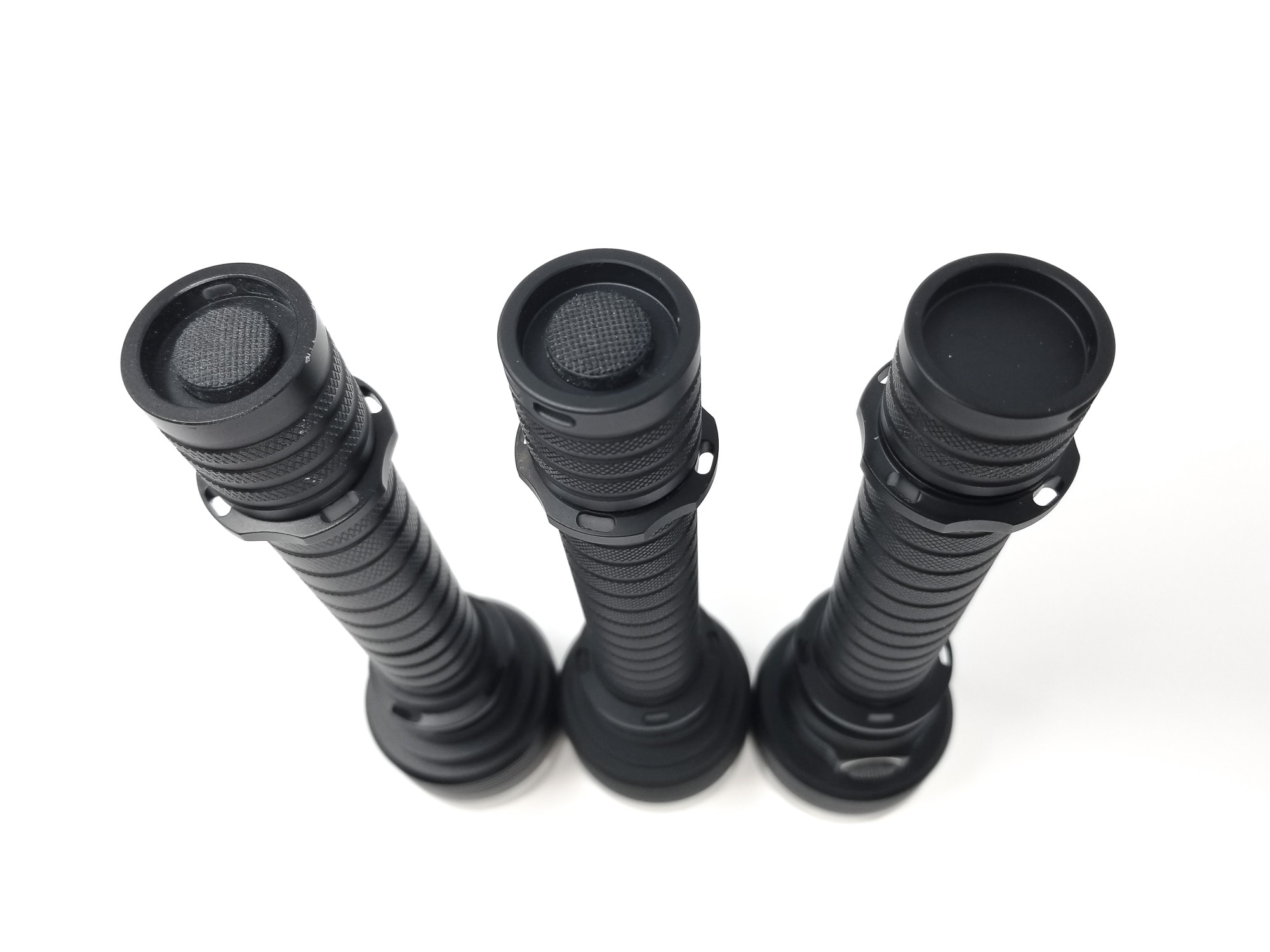
Nightwatch NS14R UI: User Interface and Driver
The driver is going to be a linear FET driver set up for 2S (2 series) input 8.4 volts. It would have been nice to see a FET+Buck driver for this ‘new’ light, but beggars can’t be choosers, right? UI is typical Nightwatch fare, and is of course lifted from the previous NS14. It’s a clicky UI that I think works a lot better on the e-switch equipped light than the reverse clicky switch version.
Available modes:
- Low, Middle 2, Middle 1, Turbo
Available blinky modes:
- Strobe
From OFF:
- Single click: Turns on in last memorized mode
- Double click: Turbo
- 3 fast clicks: Strobe
From ON:
- Press and hold: Turns off
- 1 click: Switches modes
- Double click: Turbo
- 3 fast clicks: Strobe
Mode memory:
- Yes. Remembers Low, Middle 1, Middle 2
Shortcuts:
- To Turbo: Double click
- To Strobe: Triple click
Low voltage warning/protection:
- The light will drop to a very low output before shutting off
Strobe/blinkies
- Strobe
Lock-out mode:
- Mechanical lockout by unscrewing the tailcap ⅛ turn
PWM
- None visible by eye
Additional/summary info on the UI:
- This is a very simple UI with essentially 4 modes plus Strobe. It loses two modes off the NS14 (Low and Moon), but I like it quite a lot more. Click it on, and aside from press and hold for off (which I think is a safety feature to prevent accidental activation) and I think I like using the NS14R better than the NS14 due to the e-switch. It’s less likely to be accidentally activated, and allows for more positive control of the mode switching (especially Turbo). Strobe gives you the full output in a slow-ish frequency. No LVP was specified, which was an issue Nightwatch had to fix with the progenitor of the NS14R, the NS59v1.
Nightwatch NS14R Charging and batteries
The NS14 shares the same battery configuration as the other NS siblings, so you get two 21700s arranged in series. Button top, unprotected 21700s are recommended, and they must be standard, non protected. For batteries, you really need to use matched cells (cells that have always been used together, of the same brand, capacity, and CDR), and you’re limited to the highest-current rated cells you can get which means Samsung 30Ts, Molicel P42A, P45Bs, and some of those spicy Neal-special Lishen cells.
I recommend getting the bundle with the batteries for that reason. This light came with some mystery white wrapper, Nightwatch branded 21700s labeled 21700XP 60A. The wrapper says 2500 mAh, but Neal says these are 3800 mAh. I think the actual figure is closer to 3000 mAh though since I recharged them from the storage voltages of 3.4 and 3.5 volts and got around 2950 mAh added to them each. I’m sure that would go up if discharged to 2.7 volts. There’s no onboard charging, so you need a standalone hobby charger for 21700s.
| Charge type | Fits | No fit | Charge time |
|---|---|---|---|
| None | Standard, unprotected button tops | flat top standard length, protected button tops | N/A |


Performance test
Lumen measurements
How Lumens are Measured: Understanding ANSI FL1 Standards How Lumens are Measured: Understanding ANSI FL1 Standards: The ANSI FL1 standards specify that output in lumens should be measured 30 seconds after turning on, as this is the standardized time for measuring brightness according to the industry standard. This is why we focus on this part in our measurements. The ANSI FL1 standards require an ambient temperature of 22 ± 3°C. We record the ambient the ambient temperature to identify potential reasons for any observed discrepancies.Lumens are measured in my 30 cm integrating sphere with a Digi-Sense 20250-00 data logging luxmeter. The sphere has been calibrated with a Convoy S2+ measured to 260 Lumens and the figures are within 10% of actual. Current was measured with my Thisinde B18B+ multimeter with 14 gauge wires on banana plugs in the meter and high currents with my FY219 clamp meter with a piece of 10 gauge wire in the loop. Measurements were taken using fully charged 21700XP 21700s.
| Mode | Amps at start | Specs | turn on | 30 sec | 10 minutes |
|---|---|---|---|---|---|
| Low | 550 mA | 850 | 684 lm | 684 lm | – |
| Middle 2 | 1.96 A | 2,700 | 2,277 lm | 2,277 lm | 2,250 lm |
| Middle 1 | 5.08 A | 7,000 | 5,400 lm | 5,400 lm | 0 lm |
| Turbo | 71 A | 45,000 | 36,000 lm | 27,900 lm | 1,800 lm |
Parasitic drain:
- 0.13 mA
These LEDs are pulling significantly more current than the NS14. It’s probably due to the changes in the current path (e.g. a lower-resistance path due to no mechanical switch) and maybe some LEDs with a lower thermal resistance? Either way, 71 amps at start, at 6 volts is over 400 watts. That’s a lot. Of note here is Middle 1, which shut down intermittently at times during the runtime.
Nightwatch NS14R Battery Life: Runtime graphs
How Runtimes are Measured: Understanding ANSI FL1 Standards About ANSI FL1 runtime standards: The runtime is measured until the light drops to 10% of its initial output (30 seconds after turning on). This does not mean that the flashlight is not usable anymore. The last column shows how long the light actually works till it shuts off. If there is a + symbol, it means that the test was stopped at that particular point, but the light was actually still running. This happens on certain occasions, with certain drivers, firmware, or batteries.Lumens are measured in my 30 cm integrating sphere with a Digi-Sense 20250-00 data logging luxmeter. The sphere has been calibrated with a Convoy S2+ measured to 260 Lumens and the figures are within 10% of actual. I use a Digi-Sense 20250-92 data logging thermocouple for the temperature measurements. The probe is affixed to the head using kapton tape and uses the same 5 second sampling rate for logging. I used fully charged 21700XP batteries for this test and tested Middle 1, Middle 2, and Turbo modes.
| Mode | Specified runtime | Measured runtime ANSI | Time till shut off |
|---|---|---|---|
| Middle 2 | ? | 1h 44m | 1h 44m |
| Middle 1 | ? | 7m 45sec | 2h 30m |
| Turbo | ? | 55sec | 1h 17m |
There were no advertised runtimes for the NS14R, so I don’t know if that was tested, but that’s why 1Lumen exists! The runtimes for Turbo and Middle 1 are short, as expected. The NS14 and NS9v1 also exhibited similar behaviors. The driver seems to be a high current buck driver, since the outputs are very laminar, and this time aren’t interrupted by thermal fluctuations.
Turbo starts at a very impressive (albeit down quite a lot from spec of 50,000) 36,000 Lumens, and maintains better than 20,000 Lumens for almost a full minute. In that time it gets very hot, very fast though, although not as wild as the NS14 or NS59v1. Thermal limiting drops the output a lot by 60 seconds. Middle 1 behaved oddly, with a shut down at 7 minutes 45 seconds followed by restart at the 22 minute mark (over 10 minutes), presumably as the light cooled off. Middle 2 seems pretty normal, with good sustained output for the duration of the runtime. The temps for Turbo and Middle 2 were high.
Turbo heated up super fast, but capped at about 70 C, dropping to around 60 C. This time the output wasn’t muddied by thermal fluctuations. Overall, an improvement over the non-R light, but not much. You can only do some much with 400 grams of thermal mass dealing with 400 watts. LVP works fine also, with the batteries conservatively spared a deep discharge, coming out of the light between 3.1 and 2.9 volts.
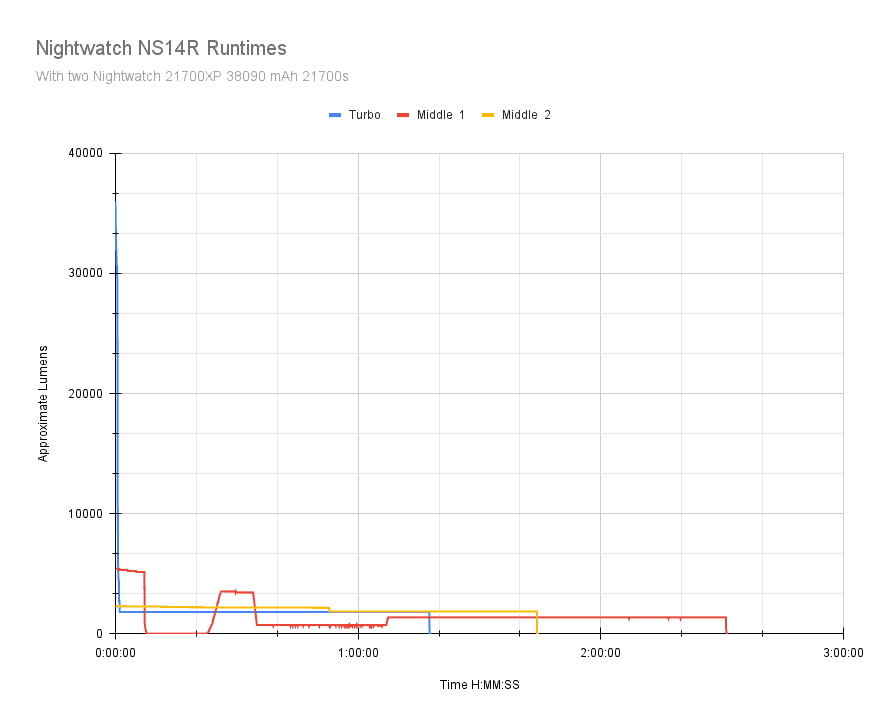
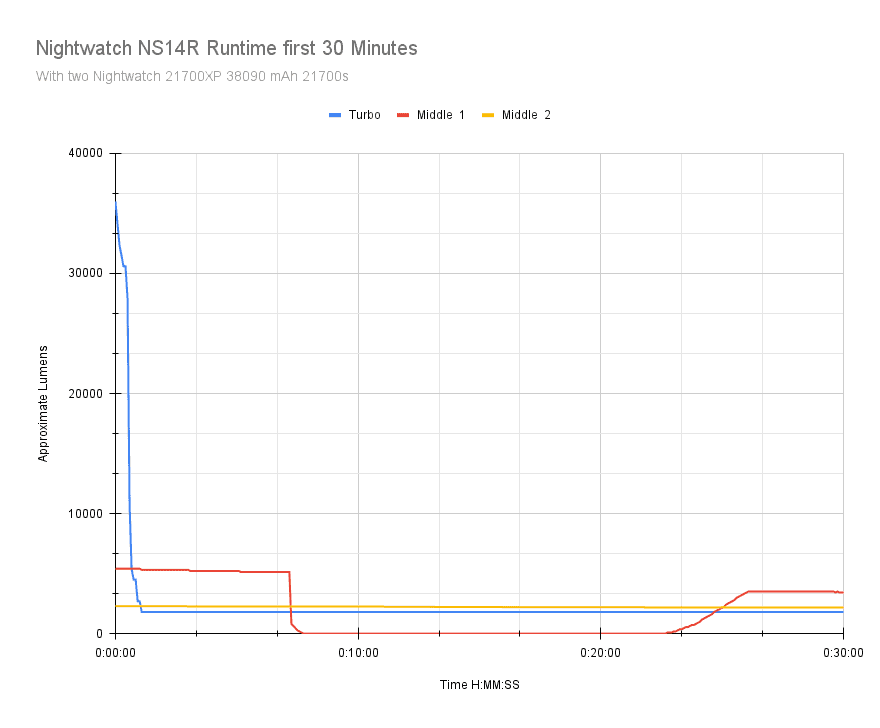
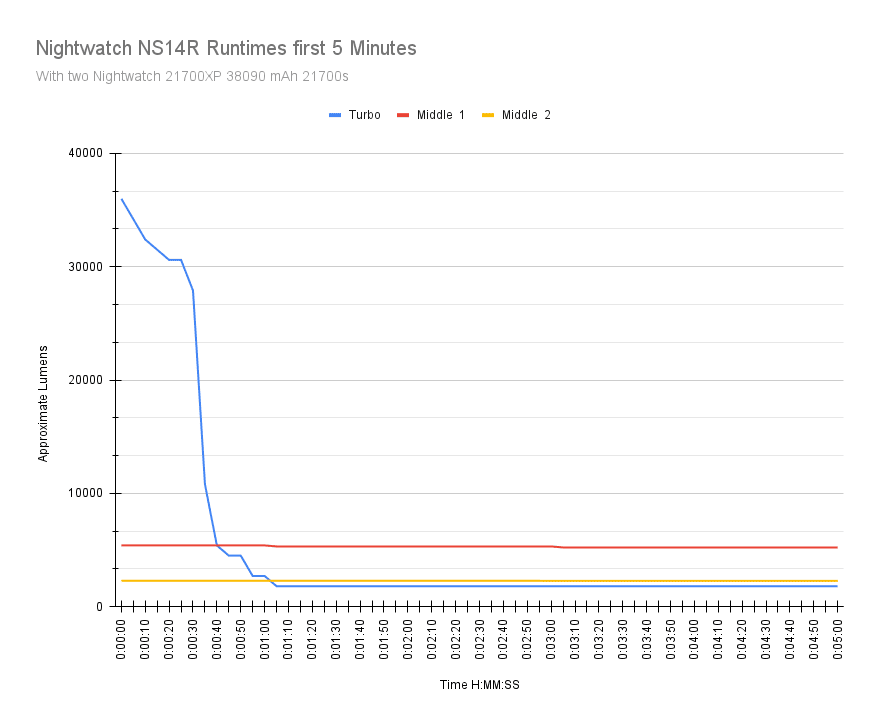
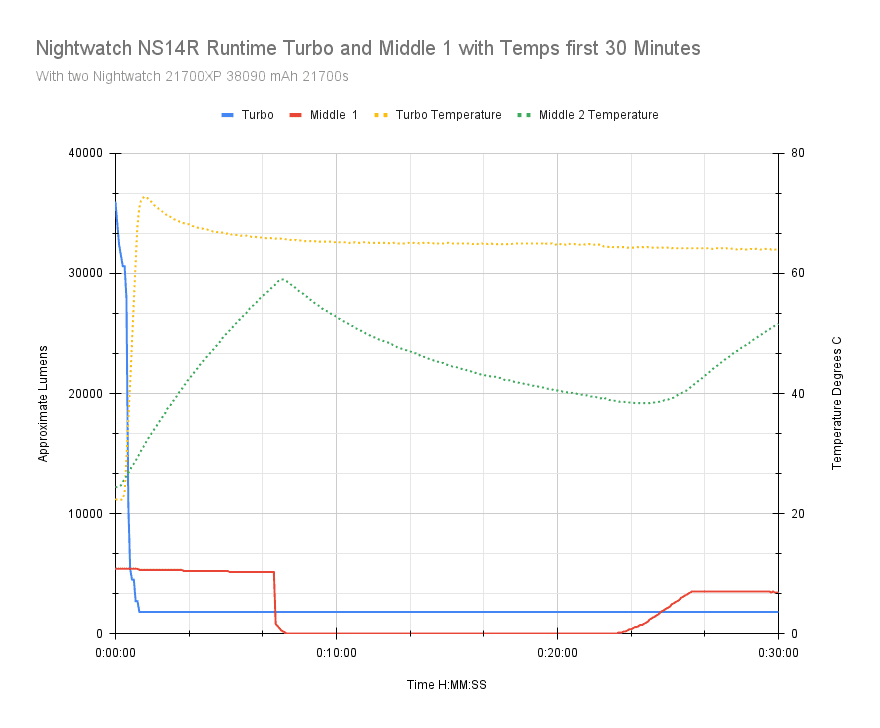

I ran a comparison of some other high output lights to show the differences in outputs and step downs over time. The NS14R doesn’t do bad considering the thermal mass deficit for sustained output.
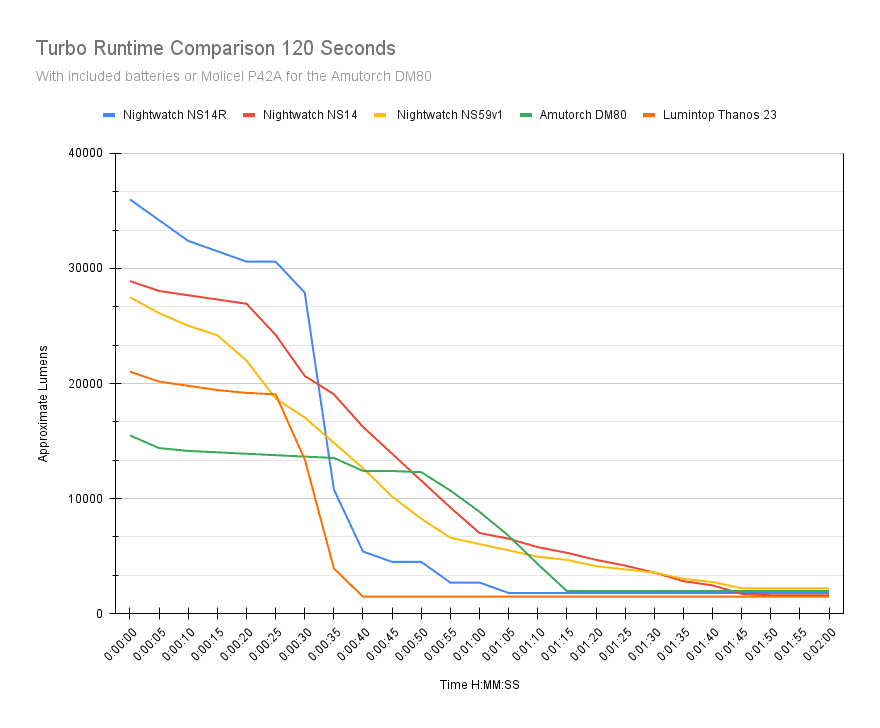
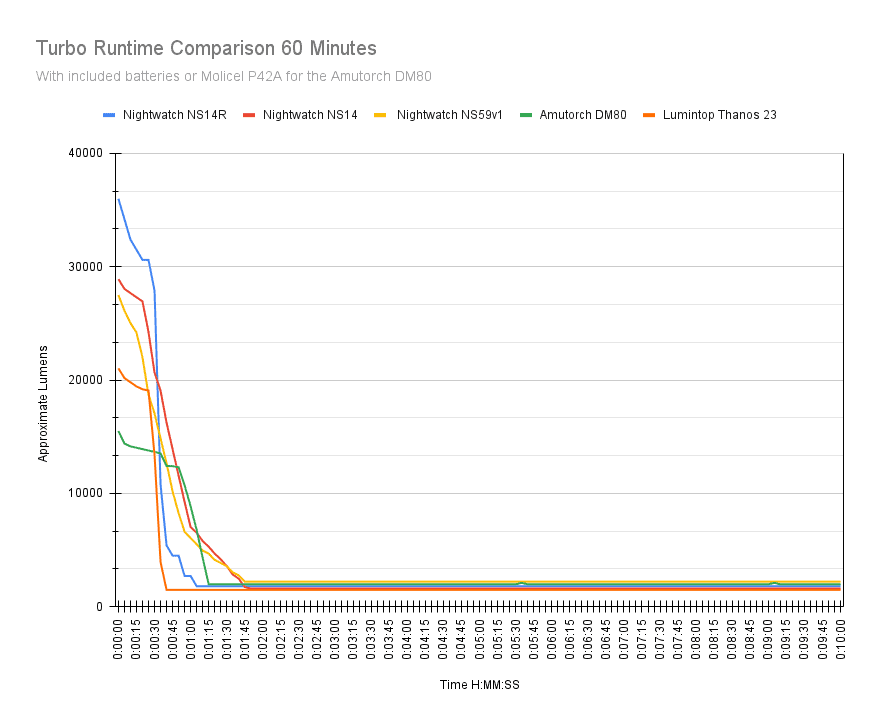
Peak beam intensity and beam distance measurements
About Peak beam intensity: Understanding ANSI FL1 Standards About peak beam intensity The calculated value of distance in meters at which the flashlight produces a light intensity of 0.25 lux. (0.25 lux is about the brightness of a full moon shining on an object). This means that the intensity has decreased so much, it becomes difficult to see darker objects, or objects that don’t reflect light. The columns ‘Meters’ and ‘Yards’ use rounded numbers.Beam distances are measured using a Uni-T UT383S luxmeter measured indoors at 5 meters using the included fully charged 21700XP batteries. Measurements taken at 30 seconds.
| Mode | Specs | Candela measured | Meters | Yards |
|---|---|---|---|---|
| Low | ? | 1600 cd | 80 | 87 |
| Middle 2 | ? | 5000 cd | 141 | 154 |
| Middle 1 | ? | 12,075 cd | 220 | 240 |
| Turbo | 100,000 cd | 68,425 cd | 523 | 572 |
| Turbo at start | ? | 83,650 cd | 578 | 632 |
The startup figure is pretty impressive, but way off the factory spec though. Still, 500+ meters of throw, even at 30 seconds, is nothing to scoff at. It’s more than enough beam distance for everything you could throw at the NS14R.
Beamshots
Photos taken with my Samsung Galaxy Note 8 with the camera set to ISO 200, 0.3s, and 5000K WB. The fence is 40 meters distant.
Beamshots of the following very high output multi-LED flashlights compared:
- Nightwatch NS59v1
- Nightwatch NS14
- Nightwatch NS14R
- Wurkkos DL70
- Haikelite HT90
- Haikelite HK90
- Wuben A1
- Lumintop Mach
- Lumintop Thanos 23
- Fenix LR80R
Please note that beamshots are mainly intended to showcase the beam pattern and beam quality, rather than overall performance. These images are typically taken directly after activation, and do not fully represent its overall performance. For accurate performance metrics, such as output, beam distance, and runtimes, you need to look at the performance section of this review.
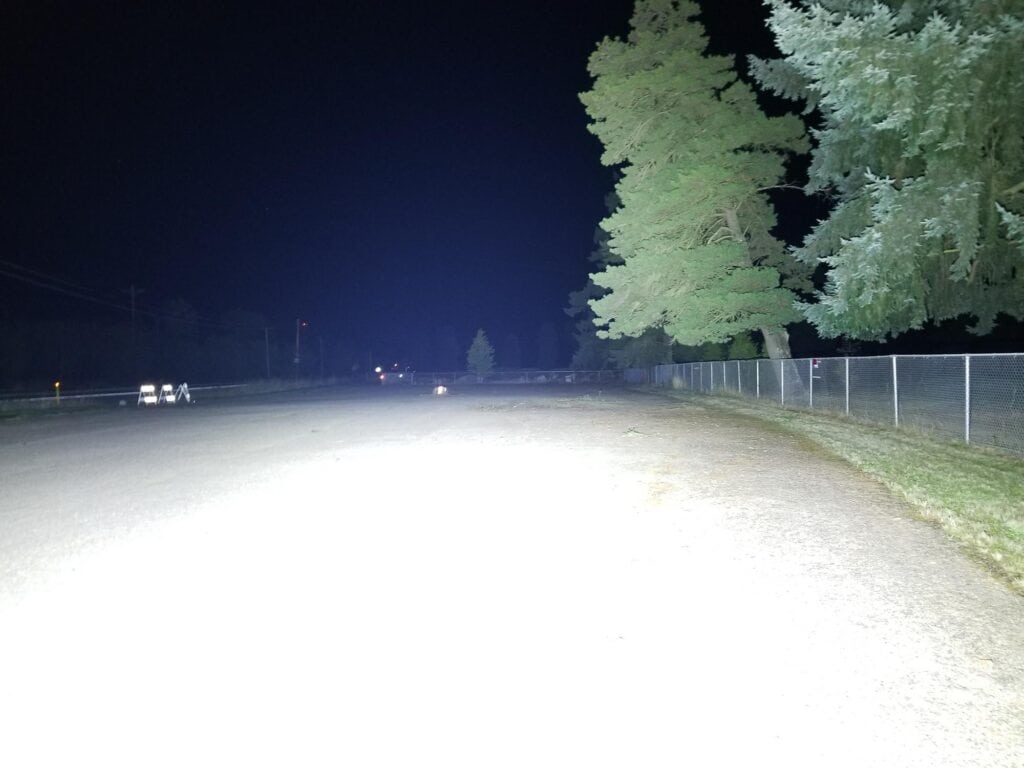
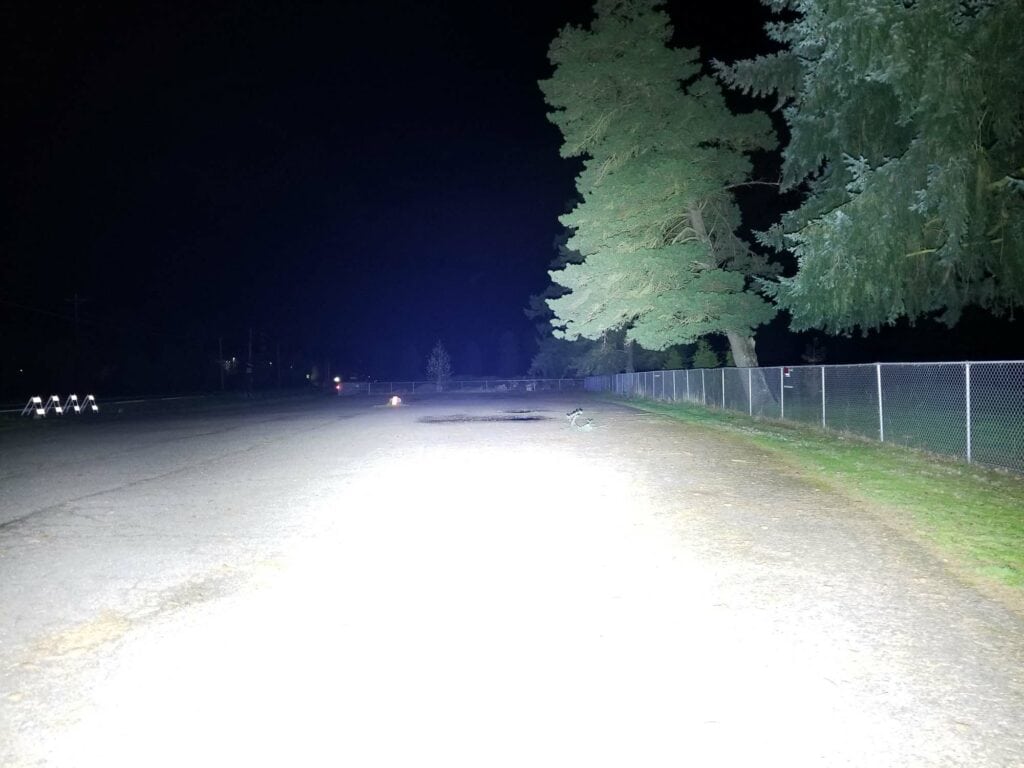
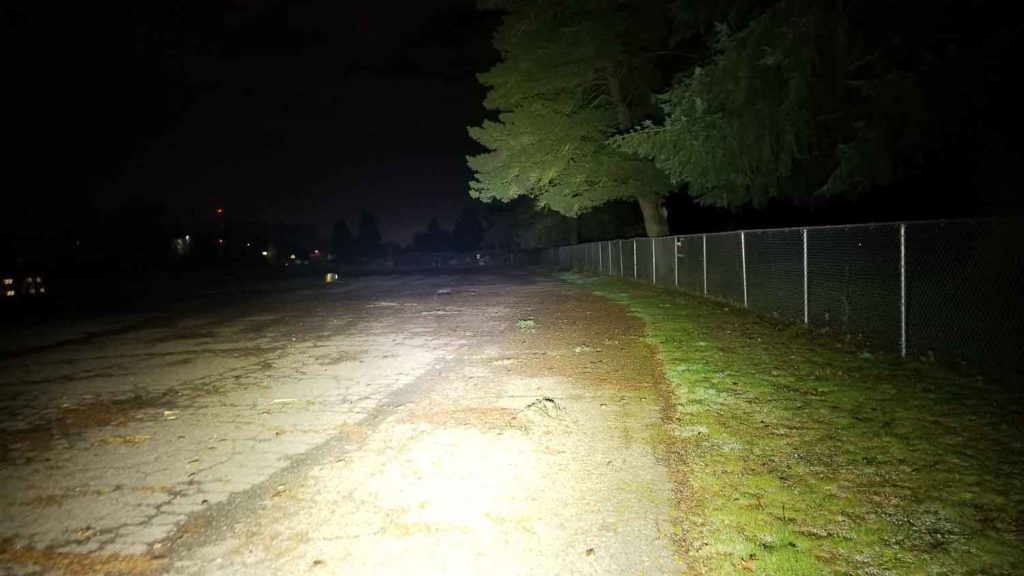

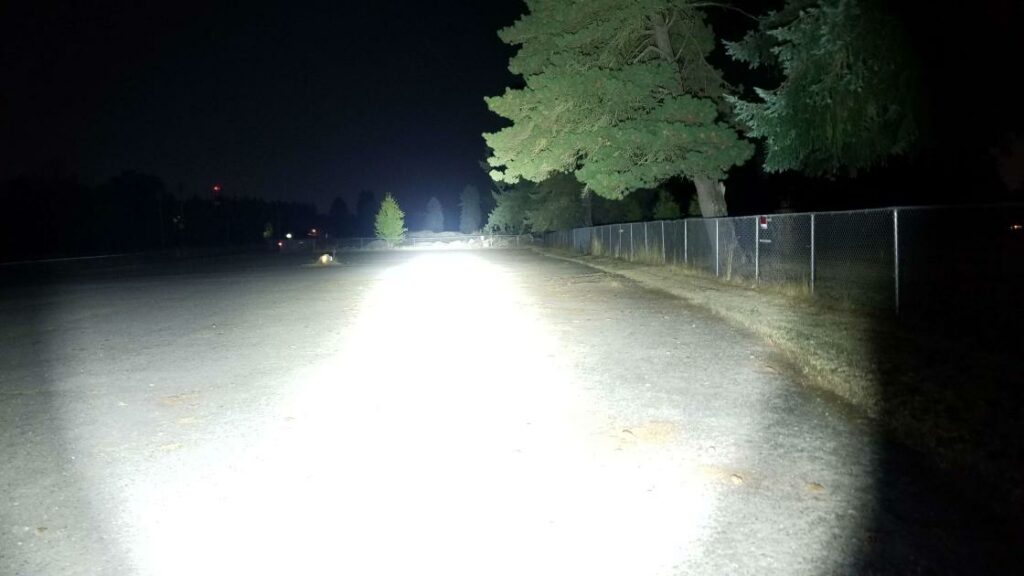
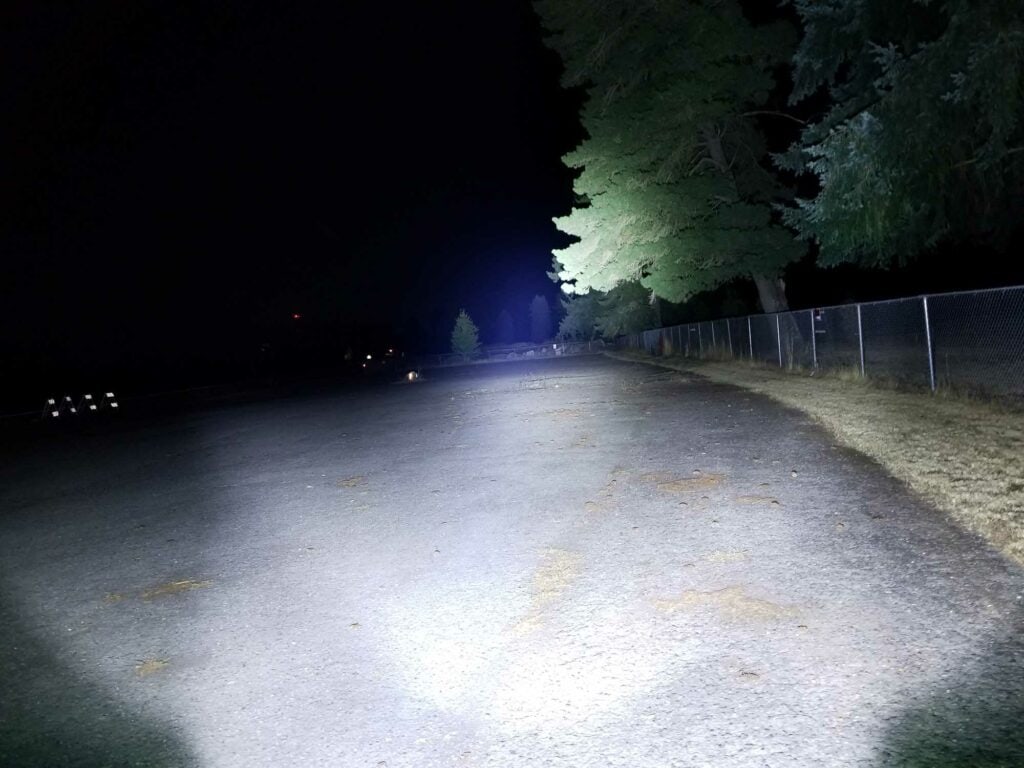
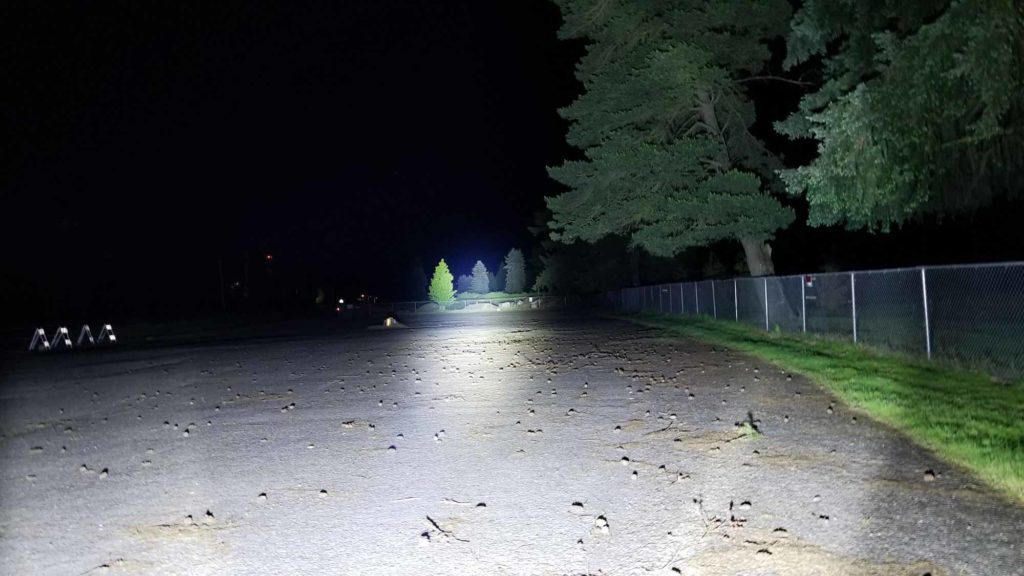
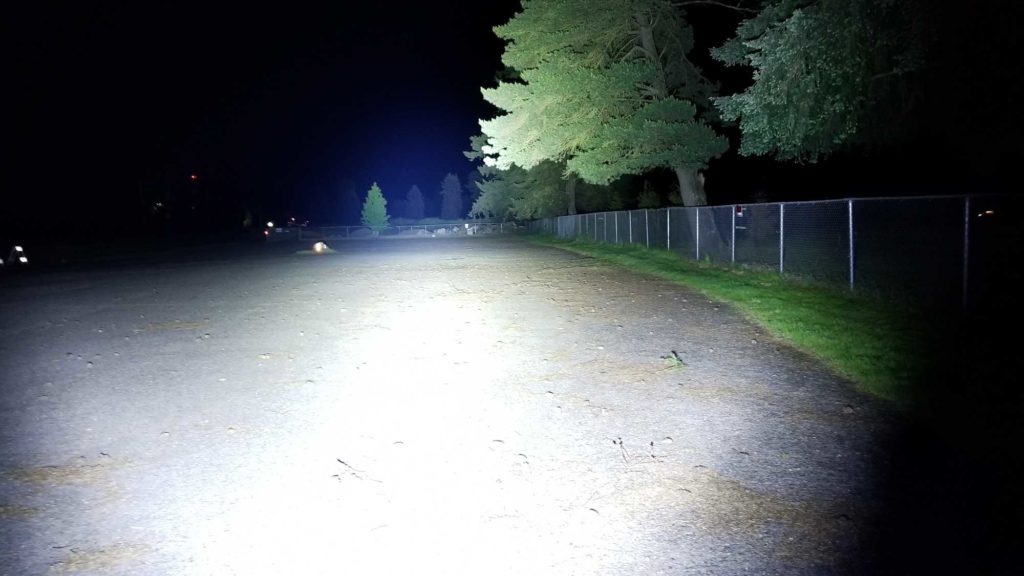
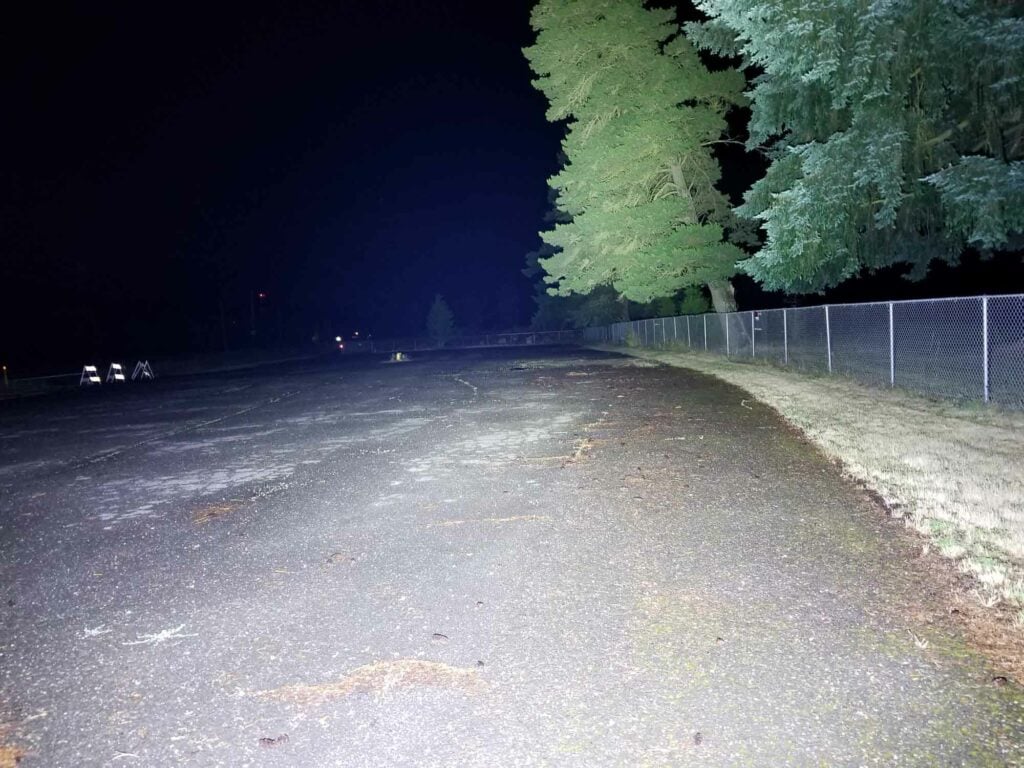
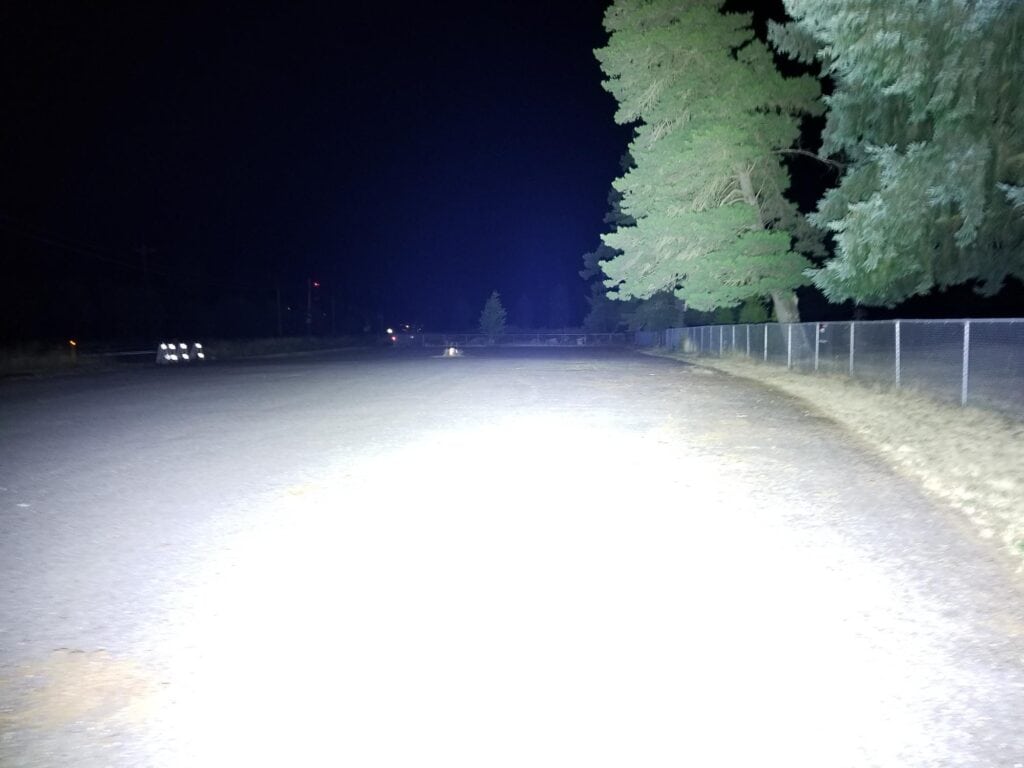
Disclaimer: This flashlight was sent to us for review at no cost by Nealsgadgets. We have not been paid to review, nor have we been holding back on problems or defects.
Final Verdict
Pros
- Side switch helps usefulness
- Somewhat improved thermal management
- Solid build quality
- Big output increase
- Regulated output
- Great beam distance and tons of flood
Cons
- Middle 1 thermal management needs work/refinement
- Needs very high drain, button top batteries
- No onboard charging
Explanation on star ratings:
1: Avoid: a match would be a better choice – 2: Poor: significant defect or issues; almost unusable – 3: Average: some defects or issues; but still usable 4: Good: recommended (minor issues) – 5: Great: highly recommended

3.5 stars: ★★★⋆
While our star rating provides a reliable indicator, we encourage you to read the full review to make an informed decision based on your own needs and preferences.
Third time’s the charm? This is actually the 4th revision of Nightwatch’s NS-series of 2×21700 high output flashlights, and I’d say this one is the best so far. I was excited to finally see an e-switch added to this light. Not that clickies are bad, it’s just that on the NS59v1, v2, and NS14, they didn’t do much for user-friendliness. The e-switch improves the handling and solved the touchiness that came with the tail clicky. Plus it enabled the NS14R a significant bump in output owing to the increased current it could pull.
That aside, what else have they improved? The solid build quality and easy handling remains, and they’ve tweaked the stepdown/thermal throttling a bit. The output is handled by a dual channel buck driver, so you’re getting regulated output in the lower modes. The domed LEDs also improved the output from the previous NS by nearly 8,000 Lumens. That’s a lot. Now, you can’t have your cake and eat it too all the time, and with this much power in a small’ish host comes some limitations.
First, it gets hot fast and stays hot, the Middle 2 mode still has the odd step down and then shut down anomaly experienced on the other NS, albeit this time the light restarted itself after about 16 minutes. An improvement? I think so, but could still benefit from refinements. You are limited to very high drain batteries with button tops to get the most out of this light, and while not a deal-breaker, there’s still no onboard charging. I digress though since Nightwatch did improve this NS in a meaningful way.
Don’t let that fool you though since this is still not a flashlight for the fainthearted, newbies, or the otherwise inexperienced. It will still burn you while simultaneously blinding you. Still, Nightwatch gets an A for effort here, and the NS14R gets 3.5 stars.
Buy your Nightwatch NS14R with a discount
Get a nice discount at Nealsgadgets with our unique discount codes: 1LumenNEW, or 1Lumen711
1lumen selects and reviews products personally. We may earn affiliate commissions through our links, which help support our testing.